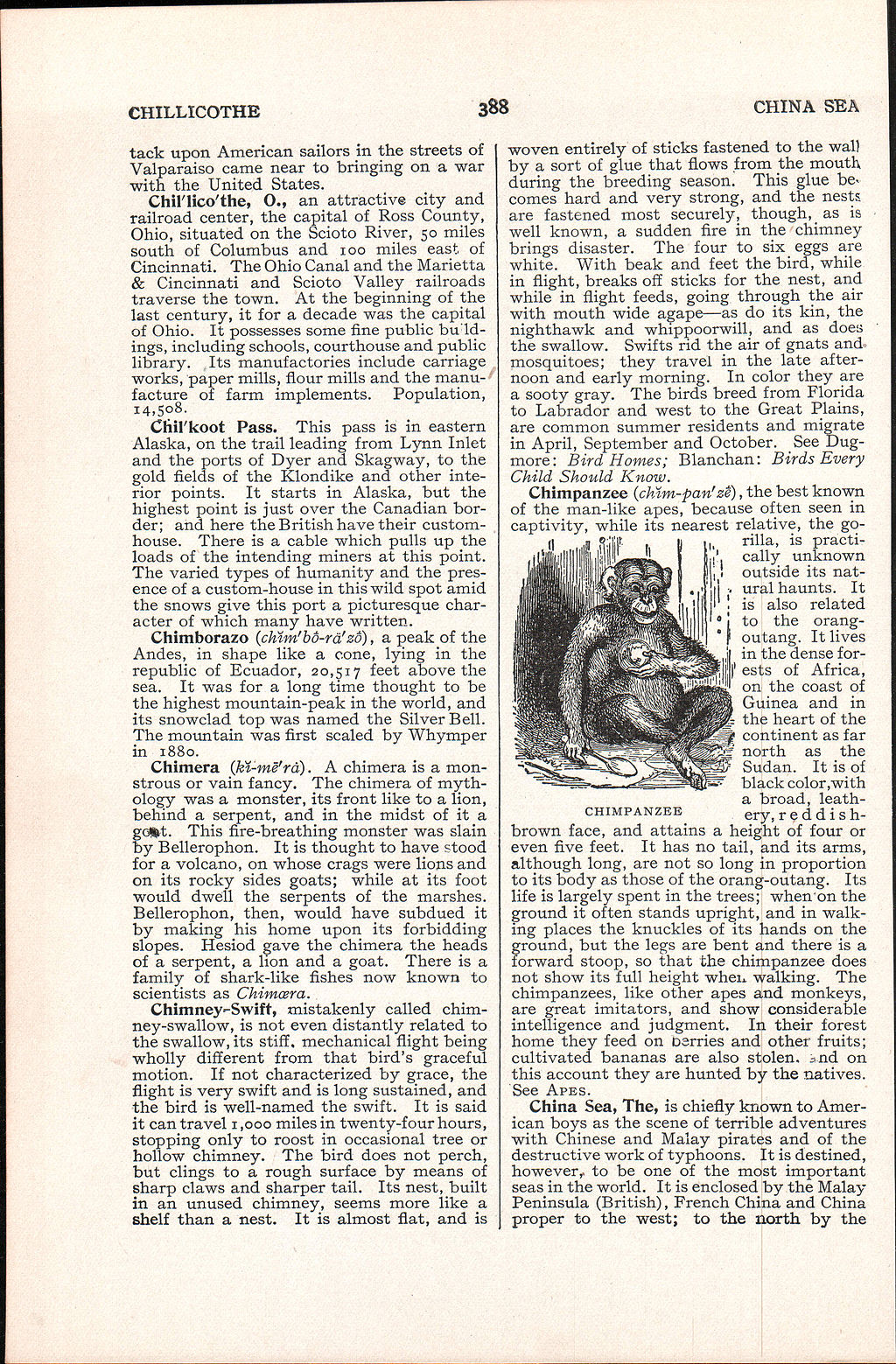Page 388 : CHILLICOTHE — CHINA SEA
Individual articles:
tack upon American sailors in the streets of Valparaiso came near to bringing on a war with the United States.
Chil′lico′the, O., an attractive city and railroad center, the capital of Ross County, Ohio, situated on the Scioto River, 50 miles south of Columbus and 100 miles east of Cincinnati. The Ohio Canal and the Marietta & Cincinnati and Scioto Valley railroads traverse the town. At the beginning of the last century, it for a decade was the capital of Ohio. It possesses some fine public buildings, including schools, courthouse and public library. Its manufactories include carriage works, paper mills, flour mills and the manufacture of farm implements. Population, 14,508.
Chil′koot Pass. This pass is in eastern Alaska, on the trail leading from Lynn Inlet and the ports of Dyer and Skagway, to the gold fields of the Klondike and other interior points. It starts in Alaska, but the highest point is just over the Canadian border; and here the British have their customhouse. There is a cable which pulls up the loads of the intending miners at this point. The varied types of humanity and the presence of a custom-house in this wild spot amid the snows give this port a picturesque character of which many have written.
Chimborazo (chĭm′ bṓ-rä′ zṓ), a peak of the Andes, in shape like a cone, lying in the republic of Ecuador, 20,517 feet above the sea. It was for a long time thought to be the highest mountain-peak in the world, and its snowclad top was named the Silver Bell. The mountain was first scaled by Whymper in 1880.
Chimera (kĭ-mē′ rȧ). A chimera is a monstrous or vain fancy. The chimera of mythology was a monster, its front like to a lion, behind a serpent, and in the midst of it a goat. This fire-breathing monster was slain y Bellerophon. It is thought to have stood for a volcano, on whose crags were lions and on its rocky sides goats; while at its foot would dwell the serpents of the marshes. Bellerophon, then, would have subdued it by making his home upon its forbidding slopes. Hesiod gave the chimera the heads of a serpent, a lion and a goat. There is a family of shark-like fishes now known to scientists as Chimœra.
Chimney-Swift, mistakenly called chimney-swallow, is not even distantly related to the swallow, its stiff, mechanical flight being wholly different from that bird’s graceful motion. If not characterized by grace, the flight is very swift and is long sustained, and the bird is well-named the swift. It is said it can travel 1,000 miles in twenty-four hours, stopping only to roost in occasional tree or hollow chimney. The bird does not perch, but clings to a rough surface by means of sharp claws and sharper tail. Its nest, built in an unused chimney, seems more like a shelf than a nest. It is almost flat, and is woven entirely of sticks fastened to the wall by a sort of glue that flows from the mouth during the breeding season. This glue becomes hard and very strong, and the nests are fastened most securely, though, as is well known, a sudden fire in the chimney brings disaster. The four to six eggs are white. With beak and feet the bird, while in flight, breaks off sticks for the nest, and while in flight feeds, going through the air with mouth wide agape—as do its kin, the nighthawk and whippoorwill, and as does the swallow. Swifts rid the air of gnats and mosquitoes; they travel in the late afternoon and early morning. In color they are a sooty gray. The birds breed from Florida to Labrador and west to the Great Plains, are common summer residents and migrate in April, September and October. See Dugmore: Bird Homes; Blanchan: Birds Every Child Should Know.
Chimpanzee (chĭm-pan′ zḗ), the best known of the man-like apes, because often seen in captivity, while its nearest relative, the gorilla, is practically unknown outside its natural haunts. It is also related to the orangoutang. It lives in the dense forests of Africa, on the coast of Guinea and in the heart of the continent as far north as the Sudan. It is of black color, with a broad, leathery, reddish-brown face, and attains a height of four or even five feet. It has no tail, and its arms, although long, are not so long in proportion to its body as those of the orang-outang. Its life is largely spent in the trees; when on the ground it often stands upright, and in walking places the knuckles of its hands on the ground, but the legs are bent and there is a forward stoop, so that the chimpanzee does not show its full height when walking. The chimpanzees, like other apes and monkeys, are great imitators, and show considerable intelligence and judgment. In their forest home they feed on Denies and other fruits; cultivated bananas are also stolen, and on this account they are hunted by the natives. See Apes.
China Sea, The, is chiefly known to American boys as the scene of terrible adventures with Chinese and Malay pirates and of the destructive work of typhoons. It is destined, however, to be one of the most important seas in the world. It is enclosed by the Malay Peninsula (British), French China and China proper to the west; to the north by the
Image: CHIMPANZEE
